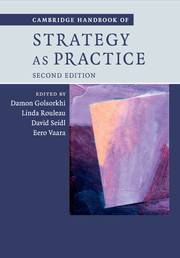Book contents
- Frontmatter
- Contents
- List of figures
- List of tables
- List of boxes
- List of contributors
- Preface to the Second Edition
- Introduction: what is strategy as practice?
- Part I Ontological and Epistemological Questions
- Part II Theoretical Resources: Social Theory
- 8 Giddens, structuration theory and strategy as practice
- 9 An activity theory approach to strategy as practice
- 10 A Bourdieusian perspective on strategizing
- 11 An economies-of-worth perspective on strategy as practice: justification, valuation and critique in the practice of strategy
- 12 A Wittgensteinian perspective on strategizing
- 13 A Foucauldian perspective on strategic practice: strategy as the art of (un)folding
- 14 A narrative approach to strategy as practice: strategy-making from texts and narratives
- 15 Actor–network theory and strategy as practice
- Part III Theoretical Resources: Organization and Management Theories
- Part IV Methodological Resources
- Part V Substantive Topic Areas
- Index
- References
15 - Actor–network theory and strategy as practice
from Part II - Theoretical Resources: Social Theory
Published online by Cambridge University Press: 05 October 2015
- Frontmatter
- Contents
- List of figures
- List of tables
- List of boxes
- List of contributors
- Preface to the Second Edition
- Introduction: what is strategy as practice?
- Part I Ontological and Epistemological Questions
- Part II Theoretical Resources: Social Theory
- 8 Giddens, structuration theory and strategy as practice
- 9 An activity theory approach to strategy as practice
- 10 A Bourdieusian perspective on strategizing
- 11 An economies-of-worth perspective on strategy as practice: justification, valuation and critique in the practice of strategy
- 12 A Wittgensteinian perspective on strategizing
- 13 A Foucauldian perspective on strategic practice: strategy as the art of (un)folding
- 14 A narrative approach to strategy as practice: strategy-making from texts and narratives
- 15 Actor–network theory and strategy as practice
- Part III Theoretical Resources: Organization and Management Theories
- Part IV Methodological Resources
- Part V Substantive Topic Areas
- Index
- References
Summary
Introduction
The aim of the chapter is to show how actor–network theorizing can contribute to our understanding of strategy as practice. Practice theorization offers a broad church, with many partially overlapping sets of interests and concerns, as discussed in the collection of writings found in The Practice Turn in Contemporary Theory (Schatzki, Knorr Cetina and von Savigny 2001). In this chapter we seek to show the variety of points of contact between the sensitivities making up a strategy-as-practice research agenda and those arising from actor–network theory as one particular part of this broader set of theories. Through such an engagement, we find opportunities for SAP research to pursue its agenda and to address a range of critiques that it has faced from those frustrated that its progress so far has not been as great as hoped.
In setting itself a core agenda, the strategy-as-practice approach questions the view that ‘strategy is something organizations have’, with a view to shifting to consideration of ‘strategy as something people do in organizations’ (Whittington 2006). Pursuing such an agenda has radical implications, questioning as it does the notion of strategy as a legitimate resource at the hands of top management. By making practice central to understanding strategy, this literature suggests that the locus of strategizing is dispersed (for anyone participating in the organization has the potential to engage in strategizing) and the instantiation of strategy may follow a complex, non-linear and less determinate trajectory involving the interplay of multiple conflicting logics.
Among all of the development and debate around the strategy-as-practice agenda, we trace some particular criticisms that have been made (namely Araujo and Easton 1996; Whittington 2006; Rasche and Chia 2009). We focus our discussion around these, since we find that they are helpful as a way to reiterate and develop central aspects of the agenda of SAP research. More importantly, given the focus of this chapter, we find that these criticisms can be directly addressed through the adoption of elements of actor–network theorizing into strategy-as-practice research. Overall, then, we present these criticisms not as judgement of the quality or intentions of the field. Rather, we see them as comments made about particular subsets of studies that serve a useful purpose as conceptual tools to further strengthen and develop the field. With this caveat on the role of these criticisms in this chapter firmly in mind, we now briefly rehearse them.
- Type
- Chapter
- Information
- Cambridge Handbook of Strategy as Practice , pp. 265 - 280Publisher: Cambridge University PressPrint publication year: 2015
References
- 5
- Cited by

